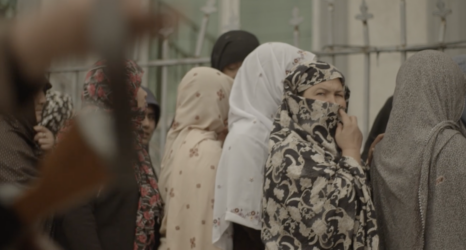Erin Bried is expanding the feminist media landscape—in demographic and in format. After working for almost 18 years as a writer and editor for women’s magazines including Glamour, Women’s Health and Fitness and Self, Bried decided to it was time to start her own publication: Kazoo Magazine, which caters to girls ages five to 10.
Bried’s choice to create a new kid of print media for children was a mindful one. Focusing on ideas and activities rather than beauty or princesses, Kazoo seeks to highlight girls’ agency. Bried sees the magazine as an opportunity to politicize girls at a critical moment in their lives, to “shore up their foundation” of empowerment before the pressures of patriarchy set in during adolescence. While Kazoo’s interactive and fact-filled pages are fun for readers in the now, Bried hopes her magazine’s real impact will reveal itself in years to come—through the number of girls still raising their hands in class, playing sports, starting businesses and dreaming big.
In a moment where many print publications are closing their doors, Kazoo and its feminist mission are thriving: Less than three years after launching, it reaches readers in 47 countries around the world, and its list of admirers includes Roxane Gay, Rosario Dawson and Alison Bechdel. (Still shopping for a young feminist this season? You can purchase Kazoo here.)
Ms. spoke with Bried about the radical potential of feminist media for children, her inspiration for starting Kazoo and how she puts feminist theory into practice on its pages.
As is common for many feminist initiatives, the personal is political with Kazoo. You’ve spoken about how the inability to find empowering media for your daughter motivated you to create your own publication. Can you tell us more about that?
I have two daughters. Ellie is seven, and Bea is two. Ellie was five at the time. She loved to play pirates. She would pretend that she was zooming past Saturn. If you couldn’t find her you had to look up because she would be in a tree. She is just so imaginative. She was not interested in princesses.
One day we went to the bookstore, and we were looking for a magazine for her. There was a Barbie magazine and My Little Pony magazine, and magazines with girls in makeup on the cover and stories about hair. Nothing that interested her at all. I was looking at these and feeling, at first, stymied. Then I got angrier and angrier the more I thought about it. This is all we can do for our daughters? This is all they’re allowed to talk about?
It was just one of those things that was kept bugging me and bugging me and I thought someone should do something about this, this is crazy! Then it dawned on me that I’m a magazine editor. Maybe that somebody is me! If you want to see a change, make it yourself, right? So, we launched a Kickstarter. We raised $171k in 30 days and we were the highest funded journalism campaign in crowd-funding history.
What makes Kazoo unique among today’s media offerings for girls?
A lot of spaces, authors and screenwriters have good intentions, and they want to show girls that they can do anything and be anything—but in the process of telling that story, the girl is still the exception to the rule. The one girl says “see, I can do it anyway!” That only reinforces stereotypes.
At Kazoo, we take it for granted that our readers know they can do anything. That they can be strong and fierce. That is just a matter of fact. They are not an anomaly that they think of themselves at that way.
There’s no other magazine like us on the newsstands. There’s no other direct competitor that is doing what we do. If you want to find stories by major women authors and major women comic artists and illustrators and you want to read stories featuring Misty Copeland and the astronaut who just came back from space, Peggy Whitman, and Margaret Atwood, no other kids’ magazine has that. If you want that for your daughter and your son, we are the only place doing it. Kazoo exists because parents want us to exist for their kids. We have no advertising in our pages because I never wanted our readers to feel like by the time they read an issue that they don’t have enough, or that they are missing something in their lives. I wanted to just spark their curiosity about the world and go out and do amazing things.
How did you decide to market Kazoo as explicitly “for girls,” and do you see potential for boys to read a magazine that takes girls’ power for granted?
I thought it was important to call it a magazine for girls, because when you look at the world, everything is geared towards boys and men. We’re talking about Hillary Clinton being possibly the first woman president and my kids can’t even understand why a woman hasn’t been president yet. You look at Congress, and it’s, what 19 percent women? And that’s hooray? You look at artists in museums and women engineers, there’s this representation issue in the world at large that is rooted in so much. I just wanted it to say that it is okay that we claim this space for our daughters.
When you look at the stats in children’s books and the stats of girl protagonists versus boy protagonists, there’s a huge imbalance there. I was talking to the researcher who did that study, and she said when you take one group of people and you write them out of these stories, it is called symbolic annihilation. When you are missing from all your stories it gives you the sense that your stories have no value and therefore you have no value.
For Kazoo, I wanted to say that of course girls have value and this magazine is for them. If you are a boy and you want to read it, everything inside will interest you—science and cooking and sports and engineering and art. None of our topics are gendered so anybody can read it but I thought it was important to claim that space for girls because there is so little space in the world that is for you.
It is really cool how collaborative Kazoo seems. Despite being an indie magazine and one-woman show, Kazoo’s roster of rock-star contributors highlights, to me, the collective spirit of feminist work. Can you tell me how you got so many powerful women to lend their energy to the project?
We have worked with such amazing experts, and I’m basically cold-calling them. We’re a new magazine and we haven’t been around for that long. But when I tell them what we’re about, 95 percent of the time they say: What do you need? What can I do to help?
We had Shonda Rhimes do a story for us on how she writes and about how to write a plot. Catherine Opie helped us make a pinhole camera out of a juice box. We had Zina Howard, who is the lead architect behind the new Smithsonian Museum in D.C. of African American History and Culture, make blueprints for building a fort out of hula hoops. We have Dolores Huerta helping other people get their voices heard. It’s just so fun, I can’t even tell you.
Though Kazoo emerges in a moment where we’re taking more and more selfies, and spending time on photo-based apps like Instagram and Snapchat, I noticed that there are no photos of anyone in its pages. What was your thinking behind that choice?
That was so important to me, because I wanted readers to get lost in their own experiences in the magazine. I never wanted the reader to feel observed or think about how they look compared to how others look. I wanted them to have this space where they could explore. I don’t want them to think about how they look and whether they look right or not. They get that from every other form of media—from advertising to commercials, from TV shows, movies. Even the toy aisle! I wanted to create this magical bubble for them where they could be totally free.
We illustrate all our experts as they were at our readers’ age. We collect childhood photos from them at six or seven years old and illustrate them, because I want our readers to feel connected to them. When you have a kid that is looking at a 40-year-old expert or a 50-year-old astronaut, that person feels far away. I want them to see what a future scientist, dancer, athlete looks like. She’s got a Band-Aid on her knee and one sock up and one sock down. She’s got on a hoodie. She looks more like me. They look closer and attainable. The readers can see themselves as an expert without taking the leap to do so.
What values do you hope to teach the next generation of feminists?
In every issue, we have a recurring page called questions where we talk about critical thinking in some way. We try to introduce ideas maybe they haven’t thought of or new ways to look at things. We also have a section on feelings because we tell girls not to show their emotions because they might be seen as too temperamental or weak, but we want them to know that their emotions are powerful and strong. I don’t know if I want them to focus on the environment or civil rights, in particular, but what interests them most. What I want our Kazoo readers to do is to think critically and to know that the world is a very large place, that we’re connected, and that we should do what we can to help each other.
The beautiful thing about creating feminist media for children is that impact entire families and inspire caregivers towards more empathy. How do you see the magazine fitting into the feminist movement?
We are a proudly feminist magazine. We don’t write in a bubble. We are very much part of the world around us. We think about what is going on in the world in politics and address that in a way that kids can understand.
When Donald Trump is railing on people and calling people names, we do a story on how to help a friend who is being bullied and telling fact from opinion, which is helpful for kids and maybe helpful for adults. Our fall issue’s theme was the “Action Issue,” and we dedicated the whole issue to the midterm elections— our answer to civic engagement for children. We had Ruth Bader Ginsberg working on a story for us. That was basically the pinnacle of my life.
It is still crazy to me that what we are doing is so radical, but it is. We are the only magazine talking to girls in that way, and this is radical but still so surprising in 2018—but taking girls’ intelligence and strength for granted is radical.





